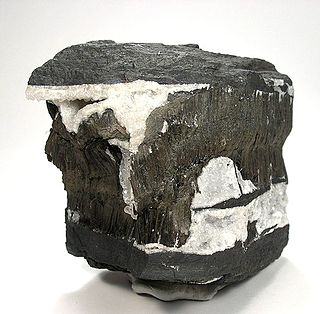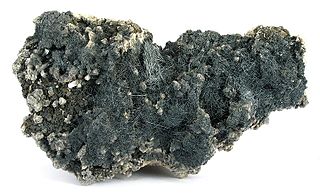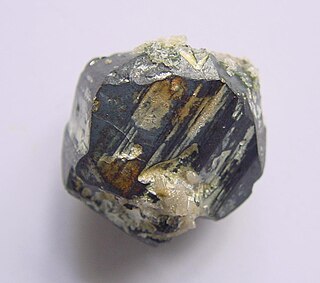Related Research Articles

Sphalerite is a sulfide mineral with the chemical formula (Zn,Fe)S. It is the most important ore of zinc. Sphalerite is found in a variety of deposit types, but it is primarily in sedimentary exhalative, Mississippi-Valley type, and volcanogenic massive sulfide deposits. It is found in association with galena, chalcopyrite, pyrite, calcite, dolomite, quartz, rhodochrosite, and fluorite.

Sulfosalt minerals are sulfide minerals with the general formula AmBnXp, where

Todorokite is a rare complex hydrous manganese oxide mineral with the chemical formula (Na,Ca,K,Ba,Sr)
1-x(Mn,Mg,Al)
6O
12·3-4H
2O. It was named in 1934 for the type locality, the Todoroki mine, Hokkaido, Japan. It belongs to the prismatic class 2/m of the monoclinic crystal system, but the angle β between the a and c axes is close to 90°, making it seem orthorhombic. It is a brown to black mineral which occurs in massive or tuberose forms. It is quite soft with a Mohs hardness of 1.5, and a specific gravity of 3.49 - 3.82. It is a component of deep ocean basin manganese nodules.

Boulangerite is an uncommon monoclinic orthorhombic sulfosalt mineral, lead antimony sulfide, formula Pb5Sb4S11. It was named in 1837 in honor of French mining engineer Charles Boulanger (1810–1849), and had been a valid species since pre-IMA. It was first described prior to 1959, and is now grandfathered.

Djurleite is a copper sulfide mineral of secondary origin with formula Cu31S16 that crystallizes with monoclinic-prismatic symmetry. It is typically massive in form, but does at times develop thin tabular to prismatic crystals. It occurs with other supergene minerals such as chalcocite, covellite and digenite in the enriched zone of copper orebodies. It is a member of the chalcocite group, and very similar to chalcocite, Cu2S, in its composition and properties, but the two minerals can be distinguished from each other by x-ray powder diffraction. Intergrowths and transformations between djurleite, digenite and chalcocite are common. Many of the reported associations of digenite and djurleite, however, identified by powder diffraction, could be anilite and djurleite, as anilite transforms to digenite during grinding.

Aguilarite is an uncommon sulfosalt mineral with formula Ag4SeS. It was described in 1891 and named for discoverer Ponciano Aguilar.
Atheneite is a rare palladium, mercury arsenide mineral with the chemical formula (Pd,Hg)3 associated with palladium–gold deposits. Its composition parallels that of arsenopalladinite, isomertieite and meritieite-II.
Babefphite is a rare phosphate mineral with the general formula BaBe(PO4)(F,OH). The name is given for its composition (Ba meaning barium, Be meaning beryllium, F meaning fluorine, and P for phosphorus).
Xilingolite is a lead sulfide mineral with formula Pb3Bi2S6. It has a hardness of 3, a metallic luster, and usually exhibits a lead-grey color. It is a dimorph of lillianite, exhibiting increased Pb-Bi order and decreased symmetry.
Madocite is a mineral with a chemical formula of Pb17(Sb,As)16S41. Madocite was named for the locality of discovery, Madoc, Ontario, Canada. It is found in the marbles of the Precambrian Grenville Limestone. It is orthorhombic and in the point group mm2. Its crystals are elongated and striated along [001] to a size of 1.5 mm.

The silver antimonide mineral dyscrasite has the chemical formula Ag3Sb. It is an opaque, silver white, metallic mineral which crystallizes in the orthorhombic crystal system. It forms pyramidal crystals up to 5 cm (2.0 in) and can also form cylindrical and prismatic crystals.

Semseyite is a rarely occurring sulfosalt mineral and is part of the class of lead antimony sulfides. It crystallizes in the monoclinic system with the chemical composition Pb9Sb8S21. The mineral forms dark gray to black aggregates.

Ardaite is a very rare sulfosalt mineral with chemical formula Pb19Sb13S35Cl7 in the monoclinic crystal system, named after the Arda River, which passes through the type locality. It was discovered in 1978 and approved by the International Mineralogical Association in 1980. It was the second well-defined natural chlorosulfosalt, after dadsonite.
Playfairite is a rare sulfosalt mineral with chemical formula Pb16Sb18S43 in the monoclinic crystal system, named after the Scottish scientist and mathematician John Playfair. It was discovered in 1966 by the Canadian mineralogist John Leslie Jambor. Lead gray to black in color, its luster is metallic. Playfairite shows strong reflection pleochroism from white to brownish gray. Playfairite has a hardness of 3.5 to 4 on Mohs scale and a specific gravity of approximately 5.72.

Guyanaite (CrOOH) is a chromium oxide mineral that forms as an intergrowth with other chromium oxide minerals known as bracewellite (CrOOH) and grimaldiite (CrOOH) as well as eskolaite (Cr2O3) which in early findings were nearly indistinguishable from one another. These oxides formed so closely as intergrowths with one another that they were initially, and erroneously, identified as a single definite mineral previously known as merumite. Because of its complex history and the previously undiscovered nature of these chromium oxide polymorphs, the relevance of any information found in many early experiments involving the mineral formerly known as merumite in regard to guyanaite is unknown and it is implied that in any further reference of merumite it will have been composed of a mineral assemblage including guyanaite. The rare occurrence and complexity from intergrowth of naturally occurring guyanaite hinders experimental work, leading to laboratory synthesized samples which help to better experiment with the minerals.

Carminite (PbFe3+2(AsO4)2(OH)2) is an anhydrous arsenate mineral containing hydroxyl. It is a rare secondary mineral that is structurally related to palermoite (Li2SrAl4(PO4)4(OH)4). Sewardite (CaFe3+2(AsO4)2(OH)2) is an analogue of carminite, with calcium in sewardite in place of the lead in carminite. Mawbyite is a dimorph (same formula, different structure) of carminite; mawbyite is monoclinic and carminite is orthorhombic. It has a molar mass of 639.87 g. It was discovered in 1850 and named for the characteristic carmine colour.
Scotlandite is a sulfite mineral first discovered in a mine at Leadhills in South Lanarkshire, Scotland, an area known to mineralogists and geologists for its wide range of different mineral species found in the veins that lie deep in the mine shafts. This specific mineral is found in the Susanna vein of Leadhills, where the crystals are formed as chisel-shaped or bladed. Scotlandite was actually the first naturally occurring sulfite, which has the ideal chemical formula of PbSO3. The mineral has been approved by the Commission on New Minerals and Mineral Names, IMA, to be named scotlandite for Scotland.
Lemanskiite is a mineral that was first discovered in a mine at Abundancia mine, El Guanaco mining district, Chile, with the ideal formula of NaCaCu5(AsO4)4Cl•3H2O. Originally, this mineral was discovered as being dimorphus with lavendulan, but in 2018 it was revised to only have 3 water molecules. Lemanskiite typically occurs as rosette-shaped aggregates of thin lamellar or needle-shaped aggregates, such as lammerite. Lemanskiite is dark sky blue with a light blue streak, it is brittle with an excellent cleavage plane. It was found on a dumping site in the abandoned Abundancia mine, El Guanaco mining district, Region II, Antofagasta Province, Chile The new mineral has been named after Chester S. Lemanski, Jr. This mineral and name were then approved by the Commission on New Minerals and Mineral Names of the International Mineralogical Association.

Segnitite is a lead iron(III) arsenate mineral. Segnitite was first found in the Broken Hill ore deposit in Broken Hill, New South Wales, Australia. In 1991, segnitite was approved as a new mineral. Segnitite has since been found worldwide near similar locality types where rocks are rich in zinc and lead especially. it was named for Australian mineralogist, gemologist and petrologist Edgar Ralph Segnit. The mineral was named after E. R. Segnit due to his contributions to Australian mineralogy.
References
- 1 2 3 4 5 Rasit, T. (1954-55) A study on the concentration tests and beneficiation of the Uludag tungsten ore Archived 2011-07-17 at the Wayback Machine . Bull. Mineral Research and Exploralion Inst. Turkey, Foreign Ed., No. 46-47, 106-127.
- 1 2 3 4 5 6 7 Anthony, J.W., Bideaux, R., Bladh, K., Nichols, M. Bursaite. (2003) Mineral Data Publishing.
- 1 2 Kraeff, A. (1973) Reflectance Values And Microhardness Tests of Bursaite Archived 2011-07-17 at the Wayback Machine . Mineral Research and Exploration Institute of Turkey, Ankara.
- 1 2 3 4 5 Borodaev, Y., Garavelli, A., Garbarino, C, Grillo, S, Mozgova, N, Uspenskaya, T. A Rare Sulfosalts from Volcano. (2001) The Canadian Mineralogist, 39 1383-1396.
- 1 2 3 Burke, E. (2006). "A Mass Discreditation of GQN Minerals" (PDF). The Canadian Mineralogist. 44 (6): 1557–1560. doi:10.2113/gscanmin.44.6.1557. Archived from the original (PDF) on 2012-03-26. Retrieved 2009-12-02.
- 1 2 Jambor, J., Burke, E. (1989) New Mineral Names. American Mineralogist, 74 1399-1404.
- 1 2 3 4 5 Fleischer, M. (1956) New Mineral Names. American Mineralogist, 41 671.
- ↑ Fleischer, M. (1972) New Mineral Names. American Mineralogist, 57 325-329.
- ↑ Neues Jahrb. (1988) Mineral, Abh. 158